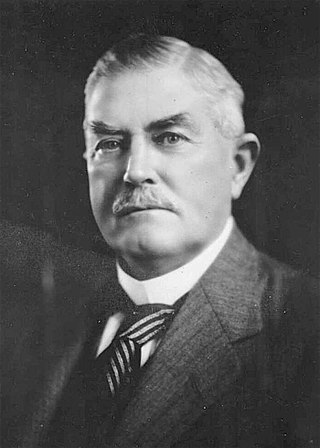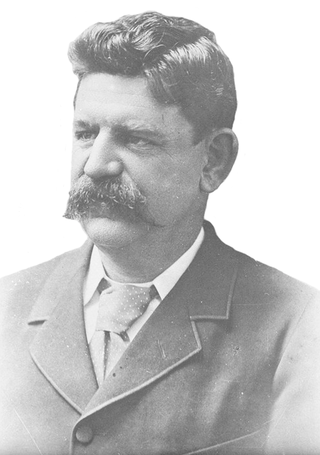
Lieutenant Colonel Sir Michael Frederick Bruxner was an Australian politician and soldier, serving for many years as leader of the Country Party in New South Wales. Born in the north of the state, Bruxner was educated at The Armidale School and started studies at University of Sydney but later dropped out to take up employment as a grazier and station agent in Tenterfield. After serving in the Citizen Military Forces from 1911, Bruxner enlisted into the Australian Light Horse upon the outbreak of the First World War in 1914. Serving with distinction in Gallipoli, Egypt and Palestine, he was promoted to lieutenant colonel and awarded the Distinguished Service Order.
Wammerawa was an electoral district for the Legislative Assembly in the Australian State of New South Wales, created in 1920, with the introduction of proportional representation and named after an alternative name for the Macquarie River. It mainly replaced Mudgee, Castlereagh and Liverpool Plains and elected three members simultaneously. In 1927, it was split into Mudgee, Castlereagh and Liverpool Plains.
John Charles Lucas Fitzpatrick was an Australian politician and journalist.
Members of the New South Wales Legislative Assembly who served in the 28th parliament of New South Wales held their seats from 1927 to 1930. They were elected at the 1927 state election, and at by-elections. The Speaker was Sir Daniel Levy.
Members of the New South Wales Legislative Assembly who served in the 27th parliament of New South Wales held their seats from 1925 to 1927. They were elected at the 1925 state election on 30 May 1925. The Speaker was James Dooley.
Members of the New South Wales Legislative Assembly who served in the 26th parliament of New South Wales held heir seats from 1922 to 1925. They were elected at the 1922 state election on 25 March 1922. The Speaker was Daniel Levy.
Members of the New South Wales Legislative Assembly who served in the 25th parliament of New South Wales held their seats from 1920 to 1922. They were elected at the 1920 state election on 20 March 1920. The Speaker was Daniel Levy with the exception of 13–20 December 1921 when he was replaced by Simon Hickey.
Christopher Augustus "Gus" Kelly was an Australian politician. He was a Labor Party member of the New South Wales Legislative Assembly from 1925 to 1932 and again from 1935 until his death in 1967, representing the electorate of Bathurst. He held numerous ministerial positions between 1941 and 1965 in McKell Labor Government.
North Shore, an electoral district of the Legislative Assembly in the Australian state of New South Wales, has had two incarnations, the first from 1920 to 1927 as a five-member electorate, the second from 1981 to the present as a single-member electorate.

William George Ashford was an Australian politician.
Goulburn, an electoral district of the Legislative Assembly in the Australian state of New South Wales, has had two incarnations, from 1859 until 1991 and from 2007 to the present.

The Fuller ministry (1922–1925) or Second Fuller ministry was the 41st ministry of the New South Wales Government, and was led by the 22nd Premier, Sir George Fuller. This ministry was the second of two occasions where Fuller was Premier.

The 1922 New South Wales state election was held on 25 March 1922. This election was for all of the 90 seats in the 26th New South Wales Legislative Assembly and it was conducted in multiple member constituencies using the Hare Clark single transferable vote. The 25th parliament of New South Wales was dissolved on 17 February 1922 by the Governor, Sir Walter Edward Davidson, on the advice of the Premier James Dooley.

The 1910 New South Wales state election was held on 14 October 1910 for all of the 90 seats in the 22nd New South Wales Legislative Assembly and it was conducted in single-member constituencies with a second ballot if a majority was not achieved on the first. Both adult males and females were entitled to vote, but not Indigenous people. The 21st parliament of New South Wales was dissolved on 14 September 1910 by the Governor, Lord Chelmsford, on the advice of the Premier Charles Wade.
The 1925 New South Wales state election was for 90 seats representing 24 electoral districts, with each district returning between 3 and 5 members. This was the third and final election in New South Wales that took place under a modified Hare-Clark voting system. The average number of enrolled voters per member was 14,690, ranging from Sturt (10,297) to Ryde (19,119).
The 1922 New South Wales state election was for 90 seats representing 24 electoral districts, with each district returning between 3 and 5 members. This was the second election in New South Wales that took place under a modified Hare-Clark voting system. The average number of enrolled voters per member was 13,785, ranging from Sturt (10,386) to Ryde (15,722).
The 1920 New South Wales state election was for 90 seats representing 24 electoral districts, with each district returning between 3 and 5 members. This was the first election in New South Wales that took place under a modified Hare-Clark voting system. The average number of enrolled voters per member was 12,805, ranging from Sturt (11,539) to Sydney (13,478).
Eastern Suburbs, an electoral district of the Legislative Assembly in the Australian state of New South Wales was created in 1920 and abolished in 1927.
Wammerawa, an electoral district of the Legislative Assembly in the Australian state of New South Wales, was created in 1920 and abolished in 1927.
St George, an electoral district of the Legislative Assembly in the Australian state of New South Wales was created in 1894 and abolished in 1904.







